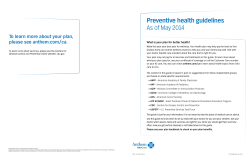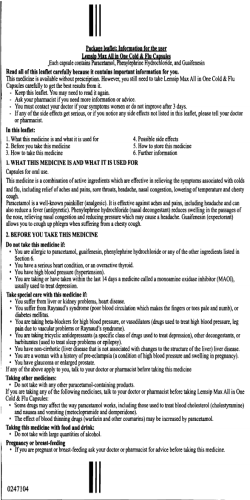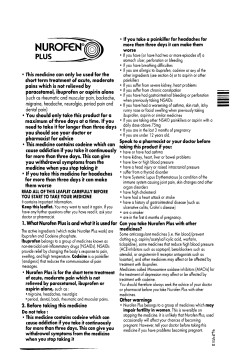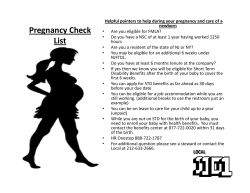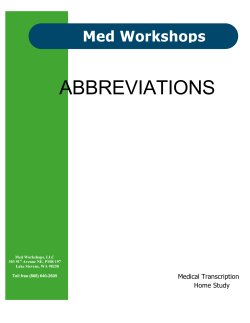
PREVENTIVE cARE What You Can Do To Protect Your Health
PREVENTIVE cARE What You Can Do To Protect Your Health • Working with your health care team • Recommended shots and screenings • Steps to take for your health What Is Preventive Care? Preventive care helps you prevent health problems before they happen. It can also help you improve your overall health and slow down the progress of diseases such as diabetes and high blood pressure. Doctors know that preventive care makes a big difference in staying healthy. Some health plans do not charge deductibles, co-pays, or co-insurance for preventive care.1 Recommended Care This workbook lists recommended preventive care by age and sex. You may not need all the tests and screenings listed. You may need some others that are not listed. The specific ones you need depend on your health risks. Ask your doctor which ones you need.1 This Workbook Can Help You •• Work with your health care team to get recommended preventive care. •• Take steps on your own to protect your health and prevent problems. Working With Your Health Care Team You are an important member of your health care team—which includes your primary care doctor, specialists, therapists, pharmacists, and others. Preventive care includes regular checkups with your primary care doctor. At these checkups, you can talk about health issues and concerns. Your doctor can give you some of the screening tests and vaccines you need—and give you referrals for others. Look ahead for… • Preventive care guidelines for children, teens, and adults. • Steps you can take to stay healthy, like eating a healthy diet. • Links to other helpful health resources on pages 28-29. 2 Preventive Care for Babies and Children Your baby or child needs regular checkups, screenings, and vaccines. Regular checkups are also called well-baby or well-child visits.2 Use this checklist to talk to your health care team about preventive care for your child. Take Your Child to the Doctor for Regular Checkups See page 28 for links to helpful children’s health resources. Checkups help you learn about your child’s health and development. They help you keep your child up to date on vaccines and screenings. They also help the doctor find problems early—when they might be easier to treat.2 o Ask your child’s doctor for a schedule of well-baby and well-child visits. o Make sure the doctor has a record of your child’s and family’s health history. o Ask if your child is developing normally. Steps to Take for Your Child’s Health Talk to your doctor about ways to help your child stay healthy: o Eat a healthy diet. See pages 22–23. o Stay active. See pages 24–25. Turn the page for more information on preventive care for babies and children. 3 Lab Tests and Screenings for Children3 Screenings help prevent health problems or catch them before they become serious. Ask when your child should get these tests and screenings: TEST/SCREENING HOW OFTEN/WHY IMPORTANT Newborn screening Infants receive several tests and screenings at birth, or soon after. Ask your doctor which tests your baby will get. Hearing At birth, and then every 1 to 2 years starting at age 4 Weight assessment From birth to 30 months, your baby’s doctor does a weight assessment at each visit. After that, at least once a year, the doctor should do a weight assessment and provide counseling on nutrition and physical activity. Lead By age 1. Lead poisoning can affect nearly every part of the body and can cause learning disabilities. Lead screening can prevent and/or decrease the risk of lead poisoning. Anemia 4 4 At 12 months. Talk to your baby’s doctor. Anemia is a low level of red cells in the blood. It can cause tiredness as well as permanent physical and mental problems. Blood pressure Yearly starting at age 3 Vision Every 1 to 3 years starting at age 3 Other tests Ask your doctor about other tests and screenings your child may need. DATE RECEIVED Vaccines for Children5,6 These are general recommendations for healthy children. Talk to your health care provider about the timing and number of doses, which may be different for your child. AGE VACCINES SERIES Birth HepB—Hepatitis B • 1st shot HepB—Hepatitis B [between 1 and 2 months] • 2nd shot DTaP—Diphtheria, tetanus, and pertussis • 1st shot PCV—Pneumococcus • 1st shot Hib—Haemophilus influenzae type b • 1st shot IPV—Polio • 1st shot RV—Rotavirus • 1st shot DTaP—Diphtheria, tetanus, and pertussis • 2nd shot PCV—Pneumococcus • 2nd shot Hib—Haemophilus influenzae type b • 2nd shot IPV—Polio • 2nd shot RV—Rotavirus • 2nd shot HepB—Hepatitis B [between 6 and 18 months] • 3rd shot DTaP—Diphtheria, tetanus, and pertussis • 3rd shot PCV—Pneumococcus • 3rd shot Hib—Haemophilus influenzae type b • 3rd shot IPV—Polio [between 6 and 18 months] • 3rd shot RV—Rotavirus • 3rd shot Flu—Influenza • Yearly MMR—Measles, mumps, and rubella • 1st shot PCV—Pneumococcus • 4th shot Hib—Haemophilus influenzae type b • 4th shot Chickenpox—Varicella • 1st shot Hep A—Hepatitis A [between 12 and 23 months] • 1st shot DTaP—Diphtheria, tetanus, and pertussis • 4th shot Hep A—Hepatitis A • 2nd shot 2 months 4 months 6 months 12 to 15 months 15 to 18 months 18 months to 4 years Flu—Influenza 4 to 6 years 4 to 10 years DATE RECEIVED • Yearly DTaP—Diphtheria, tetanus, and pertussis • 5th shot IPV—Polio • 4th shot MMR—Measles, mumps, and rubella • 2nd shot Chickenpox—Varicella • 2nd shot Flu—Influenza • Yearly 5 Preventive Care for PreTeens and Teens, Age 11 to 19 Teens and preteens need checkups once a year. They also need vaccines and screenings. Older teens often wish to get health care on their own. They may see their own doctor in their family’s health plan or go to a community or school clinic. Steps to Take for Teen and Preteen Health Encourage preteens and teens to talk to their doctor about how to: 6 o Maintain a healthy weight. See pages 20–21. o Stay active. See pages 24–25. o Eat a healthy diet. See pages 22–23. o Practice abstinence or safe sex. See page 27. o Avoid smoking. See page 26. See page 28 for links to helpful preteen and teen health resources. Lab Tests and Screenings for Preteens and Teens3 These tests and screenings help your doctor find diseases before they become a problem. Preteens and teens need preventive screenings and counseling for: DATE RECEIVED TEST/SCREENING HOW OFTEN Blood pressure Yearly Depression Discuss your risk with your doctor. Pelvic exam Every year for sexually active teen girls, including a Pap smear and exam for cervical dysplasia, precancerous cells in the cervix STIs (sexually transmitted infections) Discuss your risk with your doctor. and HIV Vision Every 1 to 3 years Weight assessment Yearly. Your doctor should provide counseling on nutrition and physical activity at least once a year if needed. Your doctor should also assess girls for eating disorders. Other tests Ask your doctor about other tests your preteen/teen might need. Turn the page for information on preventive care for preteens and teens, age 11 to 19. 7 Vaccines for Preteens and Teens5 Adolescents age 11 to 19 need the following vaccines: VACCINES HOW OFTEN Tdap—Tetanus, diphtheria, and pertussis At age 11 or 12 Flu—Influenza Yearly HPV—Human papillomavirus For girls and boys age 11 or 12. The vaccine is given in a series of 3 shots over 6 months.7 • Recommended for all preteens age 11–12 • A booster shot is recommended at age 16. Teens who MCV4—Meningococcal received MCV for the first time at age 13 through 15 years conjugate will need a one-time booster dose between the ages of 16 and 18 years. Other shots 8 Ask your doctor about other shots your preteen/teen may need, including catch-up shots for childhood vaccines. DATE RECEIVED Preventive Care for Women, AGE 19 to 49 Make sure you get the checkups, vaccines, and screenings you need. Use this checklist to talk with your health care team about preventive care. See Your Doctor Regularly8 o Ask your doctor how often you should have a complete exam. o Make sure your doctor has records of your health history and family health history. o Ask your doctor how often you should have all your medicines reviewed, including over-the-counter medicines, vitamins, supplements, and herbs. Turn the page for more information on preventive care for women, age 19 to 49. 9 Lab Tests and Screenings for Women Age 19 to 498,9 These tests and screenings help your doctor find diseases before they become a problem. Ask your doctor when you will need these tests and screenings: TEST/SCREENING HOW OFTEN Blood pressure At least every 2 years BMI (body mass index) Discuss your risk with your doctor. Breast exam Chlamydia Cholesterol Every 3 years for age 20 to 40. Women may do a monthly breast self-exam. After age 40, women should have a breast exam by their doctor every year.10 • Yearly, for age 19 to 24, if sexually active or pregnant. After that, if you have new or multiple partners or have had unprotected intercourse or have other risks. • Discuss your risk for other STIs (sexually transmitted infections) with your doctor. Between age 20 and 45, you should be screened if you have a higher risk for heart disease. You may need the test earlier if you are at risk for heart disease. Depression Discuss your risk with your doctor. Mammogram Every 1-2 years, starting at age 40. If you are under age 40, discuss your risk with your doctor. Pelvic exam/Pap test Yearly, if you are at high risk. Otherwise every 2 to 3 years Skin cancer Discuss your risk with your doctor. Vision Every 2-4 years after age 40, or as directed by eye doctor Other tests Ask your doctor about other tests and screenings you may need. 10 DATE RECEIVED Vaccines for Women Age 19 to 4911 Ask your doctor if you need any of these vaccines: VACCINES HOW OFTEN Flu—Influenza Yearly DATE RECEIVED • F or all young women, age 19 to 26, who have not had the vaccine earlier. The vaccine is given in a series of 3 shots over 6 months. • Get the shot between age 19 and 21 if you are attending college and did not get a shot earlier. Those joining the MCV4—Meningococcal military or traveling to certain areas abroad should also conjugate get the shot. • Get a booster if the first shot was before age 16. Tdap—Tetanus, • Get a 1-time “Tdap” vaccine as an adult. diphtheria, and • Get a tetanus booster every 10 years. Talk to your doctor if pertussis (whooping you have had less than 3 tetanus and diphtheria shots in your cough) life or you have a deep or dirty wound. Td—Tetanus HPV—Human papillomavirus Other shots Ask your doctor about other shots you may need. Steps to Take for Your Health See page 28 for links to helpful women’s health resources. Talk to your doctor about these steps you can take to prevent health problems: o Maintain a healthy weight. See pages 20–21. o Stay active. See pages 24–25. o Eat a healthy diet. See pages 22–23. o Practice safe sex. See page 27. o Stop smoking. See page 26. 11 Preventive Care for Men, AGE 19 to 49 Make sure you get the checkups, vaccines, and screenings you need. Use this checklist to talk to your health care team about preventive care. See Your Doctor Regularly12 o Ask your doctor how often you should have a complete exam. o Make sure your doctor has records of your health history and family health history. o Ask your doctor how often you should have all your medicines reviewed, including over-the-counter medicines, vitamins, supplements, and herbs. o Men age 45 or older should ask about aspirin therapy to reduce heart attack risks. 12 Lab Tests and Screenings for Men Age 19 to 4912 These tests and screenings help your doctor find diseases before they become a problem. Ask your doctor when you will need these tests and screenings: TEST/SCREENING HOW OFTEN Blood pressure At least every 2 years DATE RECEIVED BMI (body mass index) Discuss your risk with your doctor. Cholesterol Starting at age 35. You may need the test earlier if you are at risk for heart disease. Depression Discuss your risk with your doctor. Skin cancer Discuss your risk with your doctor. STIs (sexually transmitted infections) Discuss your risk with your doctor. and HIV Vision13 Every 2-4 years after age 40, or as directed by eye doctor Other tests Ask your doctor about other tests and screenings you may need. Turn the page for more information on preventive care for men, age 19 to 49. 13 Vaccines for Men Ages 19 to 4911 Ask your doctor if you need any of these vaccines: VACCINES HOW OFTEN Flu—Influenza Yearly HPV—Human papillomavirus • F or all young men, age 19 to 26, who have not had the vaccine earlier. The vaccine is given in a series of 3 shots over 6 months. • G et the shot between age 19 and 21 if you are attending college and did not get a shot earlier. Those joining the MCV4—Meningococcal military or traveling to certain areas abroad should also get conjugate the shot. • Get a booster if the first shot was before age 16. Tdap—Tetanus, • Get a 1-time “Tdap” vaccine as an adult. diphtheria, and • Get a tetanus booster every 10 years. Talk to your doctor if pertussis (whooping you have had less than 3 tetanus and diphtheria shots in your cough) life or you have a deep or dirty wound. Td—Tetanus Other shots 14 Ask about other shots you may need. DATE RECEIVED Steps to Take for Your Health Talk to your doctor about these steps you can take to prevent health problems: o Maintain a healthy weight. See pages 20–21. o Eat a healthy diet. See pages 22–23. o Stay active. See pages 24–25. See page 28 for links to helpful health resources. o Stop smoking. See page 26. o Practice safe sex. See page 27. 15 Preventive Care for Men and Women Age 50 and Over Older adults especially need regular exams and screenings. And they may need yearly flu shots, as well as vaccines for pneumonia and shingles.11,12,14 See Your Doctor Regularly14,15 o Ask your doctor how often you should have a complete exam. o Make sure your doctor has records of your health history and family health history. o Ask your doctor how often you should have all your medicines reviewed, including over-the-counter medicines, vitamins, supplements, and herbs. o Ask about taking aspirin to help prevent heart disease and stroke. 16 See page 28 for links to helpful health resources for seniors. Lab Tests and Screenings for Men and Women Age 50 and Over14,15 These tests and screenings help your doctor find diseases before they become a problem. Ask your doctor when you will need these tests and screenings: DATE RECEIVED TEST/SCREENING HOW OFTEN Abdominal aortic aneurism (AAA) [men] 1-time screening in men age 65 to 75 who have ever smoked Blood pressure At least every 2 years BMI (body mass index) Discuss your risk with your doctor. Bone density16 • Women over age 65 and men over age 70 • Women under age 65 and men under age 70 with risk factors Cholesterol Check regularly Colonoscopy Discuss your risk with your doctor. Depression Discuss your risk with your doctor. Hearing Discuss your risk with your doctor. Mammogram Discuss your risk with your doctor. Pelvic exam/Pap test Every 1 to 3 years. After age 65, you should continue to get regular pelvic exams, but you can ask your doctor if you need to keep getting a Pap test. Skin cancer Discuss your risk with your doctor. STIs (sexually transmitted infections) and HIV Discuss your risk with your doctor. Vision /glaucoma13 Other tests • Every 1-3 years between age 55 and 64 • Every 1-2 years starting at age 65 Ask your doctor about other lab tests or screenings you may need. Turn the page for more information on preventive care for men and women age 50 and over. 17 Vaccines for Men and Women Age 50 and Over11 Ask your doctor about these vaccines: VACCINES HOW OFTEN Flu—Influenza Yearly • Get a 1-time shot at age 65 if you didn’t get it earlier. Pneumonia • G et it earlier if you smoke or have certain medical conditions, like asthma. Shingles Get a 1-time shingles vaccine at age 60 or older. Tdap—Tetanus, diphtheria, • Get a 1-time “Tdap” vaccine as an adult. and pertussis (whooping • G et a tetanus booster every 10 years. Talk to your doctor if you have had cough) less than 3 tetanus and diphtheria shots in your life or you have a deep or dirty wound. Td—Tetanus Other shots 18 Ask about other shots you may need. DATE RECEIVED Steps to Take for Your FAMILY’S Health Along with getting checkups, lab tests, screenings, and vaccines you need, there are many things you can do to help yourself and your family stay healthy. Steps to Take for Healthy Living Talk to your doctor about these steps you can take to prevent health problems for your family or yourself: o Maintain a healthy weight. See pages 20–21. o Eat a healthy diet. See pages 22–23. o Stay active. See pages 24–25. o Stop smoking. See page 26. o Practice safe sex. See page 27. 19 Are You at a Healthy Weight? For adults, one way to figure out if you are within a healthy weight range is to use the body mass index, or BMI, below.17 1. Look on the chart for your height. Then look across to find your weight. 2. If your weight is found under the overweight or obese column, you should talk to your doctor. 3. You and your doctor can make a plan so you can get closer to a healthy weight. Body Mass Index by Height and Weight17 Normal (18.5-24.9 BMI) Height (in) Overweight (25-29.9 BMI) Obese (≥30 BMI) Body Weight (lb) 58” 91-118 119-142 143 or more 59” 94-123 124-147 148 or more 60” 97-127 128-152 153 or more 61” 100-131 132-157 158 or more 62” 104-135 136-163 164 or more 63” 107-140 141-168 169 or more 64” 110-144 145-173 174 or more 65” 114-149 150-179 180 or more 66” 118-154 155-185 186 or more 67” 121-158 159-190 191 or more 68” 125-163 164-196 197 or more 69” 128-168 169-202 203 or more 70” 132-173 174-208 209 or more 71” 136-178 179-214 215 or more 72” 140-183 184-220 221 or more 73” 144-188 189-226 227 or more 74” 148-193 194-232 233 or more 75” 152-199 200-239 240 or more 76” 156-204 205-245 246 or more For more information, visit http://www.cdc.gov/healthyweight/assessing/bmi/. 20 See page 28 for links to resources that can help you maintain a healthy weight. How Do You Get to and Stay at a Healthy Weight?18 Food has calories. We use the calories for energy. Extra calories are stored in the body as fat. You need to balance the calories you eat and the calories you actually use. •• To stay at your current weight, you need to use all the calories you eat. •• To lose weight, you need to eat fewer calories than you use. •• Do not try to lose weight too fast. A good goal for most adults is to lose 1 to 2 pounds a week. If you are very overweight, ask your doctor if you should try to lose more weight each week. The best way to lose weight or to stay at a healthy weight is to eat a healthy diet and be active every day. Maintain a Healthy Weight18 There are many good reasons to stay at a healthy weight. Extra weight puts you at a higher risk for many health problems, including high blood pressure, high cholesterol, heart disease, stroke, type 2 diabetes, and colon and breast cancer. It can also cause joint problems and breathing problems. 21 19 Eat a Healthy Diet Eating a healthy diet helps you maintain a healthy weight. It also helps lower your risk for type 2 diabetes, heart disease, and other health problems. What Is a Healthy Diet?19 A healthy diet includes a variety of: •• Fruits and vegetables. •• Whole grains like brown rice, oatmeal, and whole wheat bread. •• Fat-free or low-fat milk and dairy products, or substitutes like soy milk. •• Fish, chicken, lean meat, beans, eggs, and nuts. 22 A Healthy Diet Will Limit19: •• Saturated and trans fats—fatty meats and bakery foods. •• Salt (sodium). •• Added sugar—sweets, sodas, juice drinks. A Healthy Diet Also19: •• Balances the calories you eat with the calories you use. •• Controls portion size. For example, divide your dinner plate into 4 equal parts. Fill 1 part with vegetables and 1 part with fruit. And fill 1 part with meat or beans and 1 part with a grain, like rice or pasta. If You Need to Lose Weight19 To lose weight, you need to eat less. A good way to do this is to: •• Eat smaller serving sizes. •• Eat more healthy foods—especially fruits and vegetables. •• Choose fewer unhealthy foods, like sweets, fried foods, and sodas. Healthy Eating for the Whole Family19 Help your children grow up with healthy habits. •• Make healthy meals and snacks. •• Keep unhealthy food out of the house. A healthy diet helps lower your risk of type 2 diabetes, heart disease, and high blood pressure. 23 Be Active 20 Being active helps you maintain a healthy weight. When you are active, you use more calories. Being active also helps reduce your risk for high blood pressure, heart disease, stroke, type 2 diabetes, and osteoporosis. And it may reduce symptoms of arthritis, depression, and anxiety. The Whole Family Needs Physical Activity20 •• Children and teens need at least 1 hour of physical activity each day. •• Adults need at least 30 minutes of moderate physical activity, 5 days per week. •• Help your children learn good habits by doing active things as a family, like going on walks or playing outdoor games. 24 Be sure to check with your doctor before starting an exercise routine. What Counts as Being Active?20 Moderate activity means your breathing and heart rate are faster than usual, but you can still talk while you are doing the activity. Some examples of moderate activity are: •• Walking briskly. •• Biking on level ground. •• Mowing the lawn or raking leaves. Vigorous activity means your breathing and heart rate are too fast to talk while you are doing the activity. Some examples of vigorous activity are: •• Running, jogging, or walking quickly uphill. •• Biking at high speed. •• Playing basketball, soccer, and other competitive sports. If You Need to Lose Weight20 To lose weight, you need to use more calories than you eat. If you are not an active person, start with small periods of an activity you enjoy. Build up to longer periods of activity. Tips for Success20 Set goals and track your progress. Reward yourself to celebrate successes. •• Start slowly. Work up to 30 minutes a day. Aim for 60 minutes if you need to lose weight. •• Set goals and track your progress. Then reward yourself to celebrate your success. •• Try a variety of activities. Do different things on different days. •• Be active with family and friends. 25 Do Not Smoke 21 Smoking is harmful to almost every part of your body. It increases your risk for heart disease, stroke, and many cancers, from lung cancer to kidney cancer. Quitting is not easy, but many people do it every year. And there are lots of programs to help you quit. Many health plans offer programs to help you stop smoking. Talk to your health care team. And remember to protect your family from secondhand smoke. It can harm children’s lungs. Do not allow smoking in the home or the car. See page 29 for links to resources to help you quit smoking. 26 Practice Safe Sex 22 Sexually transmitted infections, or STIs, are passed from one partner to another. This happens during sexual intercourse and other sexual contact, such as anal and oral sex. There are many STIs, including chlamydia, herpes, genital warts, hepatitis B, and HIV. Ways to Protect Yourself and Your Partner22: •• Use condoms. Condoms help prevent the spread of STIs. They also help prevent pregnancy. •• Limit the use of alcohol or drugs before sex. They affect your judgment. •• Get regular screening and lab tests. Talk with your doctor about tests for chlamydia, HIV, and other STIs. •• If you have an STI, get treated. STIs can cause infertility, cancer, and other serious problems if they are not treated. Some STIs, like HIV, can cause death. If You Want to Get Pregnant or Might Get Pregnant23: A healthy pregnancy starts before the mother gets pregnant. Talk to your doctor if you might get pregnant. •• Ask about prenatal vitamins and other ways to protect the health of your baby. •• Get tested and treated if you think you might have an STI. Some STIs can cause serious problems in babies. •• Avoid alcohol, drugs, and smoking if you are pregnant. These can cause serious problems in babies. •• If you don’t want to get pregnant, talk to your doctor about family planning. 27 Resources to Help Improve Overall Health and Well-being American Academy of Pediatrics www.aap.org Information on children’s health Healthfinder www.healthfinder.gov Health tools and preventive health information KidsHealth www.kidshealth.org Information on children’s and teen’s health National Institute on Aging www.nia.nih.gov 1-800-222-2225 Information for seniors Office on Woman’s Health www.womenshealth.gov 1-800-994-9662 Information on women’s health Resources to Help Maintain a Healthy Weight Aim for a Healthy Weight www.nhlbi.nih.gov/health/public/heart/obesity/lose_wt/ Information and tips on reaching and maintaining a healthy weight Physical Activity Guidelines for Americans www.health.gov/paguidelines/guidelines Safe and appropriate tips on being more active We Can! www.nhlbi.nih.gov/health/public/heart/obesity/wecan Tips to help children be active and eat a healthy diet 28 Resources to Help Quit Smoking Smoke Free www.smokefree.gov A step-by-step guide for quitting smoking, tools to help you quit, and phone numbers for talking to a counselor American Lung Association http://www.helpguide.org/mental/quit_smoking_cessation.htm A free program from the American Lung Association to help you quit American Cancer Society www.cancer.org/Healthy/StayAwayfromTobacco/GuidetoQuittingSmoking/Index A free program to help you quit Pathways to Freedom: Winning the Fight Against Tobacco www.cdc.gov/tobacco/quit_smoking/how_to_quit/pathways A quit smoking program created by and for African Americans Enjoy Living Smoke Free www.nhlbi.nih.gov/health/public/heart/other/latino/smoke A quit smoking program for Latinos 29 Notes 30 Notes 31 References 1.US Department of Health and Human Services. Preventive care. http://www.healthcare.gov/law/provisions/ preventive/index.html. Updated July 25, 2012. Accessed June 10, 2013. 12.Agency for Healthcare Research and Quality. Men: stay healthy at any age. AHRQ Publication No. 10-IP004-A, September 2010. AHRQ, Rockville, MD. http://www.ahrq. gov/ppip/healthymen.htm. Accessed June 10, 2013. 2.US Department of Health and Human Services. Benefits for women and children of new affordable care act rules on expanding prevention coverage. http://www.healthcare. gov/news/factsheets/benefits_for_women_and_children_. html. Posted July 14, 2010. Accessed June 10, 2013. 13.American Academy of Ophthalmology. Policy statement. Frequency of ocular examinations. http://one.aao.org/ asset.axd?id=43c49de7-89f6-4125-8e5a-cafcae846bf5. Accessed June 10, 2013. 3.American Academy of Pediatrics. Recommendations for preventive pediatric health care (Periodicity schedule). http://www.aap.org/en-us/professional-resources/ practice-support/financing-and-payment/Documents/ Recommendations_Preventive_Pediatric_Health_Care.pdf. Accessed June 10, 2013. 4.Baker RD, Greer FR; Committee on Nutrition. Clinical report—Diagnosis and prevention of iron deficiency and iron-deficiency anemia in infants and young children (0-3 years of age). Pediatrics. 2010;126:1040-1050. 5.Centers for Disease Control and Prevention. 2013 recommended immunizations for children from 7 through 18 years old. http://www.cdc.gov/vaccines/who/teens/ downloads/parent-version-schedule-7-18yrs.pdf. Last updated January 16, 2013. Accessed June 10, 2013. 6.Centers for Disease Control and Prevention. 2013 recommended immunizations for children from birth through 6 years old. http://www.cdc.gov/vaccines/parents/ downloads/parent-ver-sch-0-6yrs.pdf. Last updated April 26, 2011. Accessed June 10, 2013. 7.Centers for Disease Control and Prevention. Human papillomavirus (HPV) vaccines. www.cdc.gov/hpv/vaccine. html. Updated February 5, 2013. Accessed June 10, 2013. 8.US Department of Health and Human Services. Womenshealth.gov. A lifetime of good health. Your guide to staying healthy. http://www.womenshealth.gov/ publications/our-publications/lifetime-good-health/ LifetimeGoodHealth-English.pdf. Accessed June 10, 2013. 9.US National Library of Medicine and National Institutes of Health. Health screening for women age 18-39. http://www.nlm.nih.gov/medlineplus/ency/article/007462. htm. Updated May 28, 2012. Accessed June 10, 2013. 10.American Cancer Society. Breast Cancer. http://www. cancer.org/acs/groups/cid/documents/webcontent/003090pdf.pdf. Accessed August June 10, 2013. 11.Centers for Disease Control and Prevention. Recommended adult immunization schedule—United States, 2013. http:// www.cdc.gov/vaccines/schedules/downloads/adult/adultschedule.pdf Accessed June 10, 2013. HE85531 0713 Printed in USA. ©2013, Lilly USA. All rights reserved. 14.Agency for Healthcare Research and Quality. Men: Stay Healthy at 50+. July 2011. Agency for Healthcare Research and Quality, Rockville, MD. http://www.ahrq.gov/patientsconsumers/patient-involvement/healthy-men/men-over-50. html. Accessed June 10, 2013. 15.Agency for Healthcare Research and Quality. Women: Stay Healthy at 50+. July 2011. Agency for Healthcare Research and Quality, Rockville, MD. http://www.ahrq.gov/patientsconsumers/prevention/lifestyle/women-over-50.html. Accessed June 11, 2013. 16.Medline Plus. Bone mineral density test. http://www. nlm.nih.gov/medlineplus/ency/article/007197.htm. Updated November 8, 2012. Accessed June 10, 2013. 17.National Institutes of Health. Clinical guidelines on the identification, evaluation, and treatment of overweight and obesity in adults. http://www.nhlbi.nih.gov/guidelines/ obesity/ob_gdlns.pdf. Published September 1998. Accessed June 10, 2013. 18.US Department of Agriculture and US Department of Health and Human Services. Dietary Guidelines for Americans, 2010. 7th Edition, Washington, DC: U.S. Government Printing Office, December 2010. http://www.cnpp.usda.gov/ Publications/DietaryGuidelines/2010/PolicyDoc/PolicyDoc. pdf. Accessed June 10, 2013. 19.Centers for Disease Control and Prevention. Healthy Weight it’s not a diet, it’s a lifestyle! Updated October 25, 2012. http:// www.cdc.gov/healthyweight/index.html. Accessed June 10, 2013. 20.Centers for Disease Control and Prevention. Physical activity for a healthy weight. Updated September 13, 2011. http://www.cdc.gov/healthyweight/physical_activity/index. html. Accessed June 10, 2013. 21.Centers for Disease Control and Prevention. Health effects of cigarette smoking. http://www.cdc.gov/tobacco/ data_statistics/fact_sheets/health_effects/effects_cig_ smoking/#overview. Updated January 10, 2012. Accessed June 10, 2013. 22.World Health Organization. Sexually transmitted infections. http://www.who.int/mediacentre/factsheets/fs110/en/ index.html. Updated May 2013. Accessed June 10, 2013. 2 3.Centers for Disease Control and Prevention. During pregnancy. http://www.cdc.gov/ncbddd/pregnancy_gateway/ during.html. Updated July 26, 2011. Accessed June 10, 2013.
© Copyright 2025

